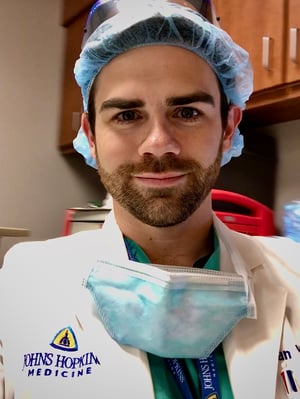When the first cases of COVID-19 were diagnosed in Maryland back on March 5th, I knew my life as a doctor at Johns Hopkins Hospital was about to change. That feels like a lifetime ago now, and it has only been one month. Now, as I write this, the number of cases diagnosed around the world has just passed the 1,200,000 mark, and the number of reported deaths unfortunately grows above 65,000 (meanwhile the United States accounts for approximately 25% of those cases, and about 1 in 8 deaths).
 This is not to say we in the healthcare community haven’t been preparing. During this time, hospitals, including my own, have been instituting a number of changes in order to conserve resources while minimizing risk to patients, visitors, and staff. For instance, elective cases (non-emergent procedures/operations) were cancelled or postponed to save resources (such as rooms, personnel, and personal protective equipment [PPE]), very few visitors are allowed in the hospital, and research not having to do with treating or preventing COVID-19 has been temporarily halted. As a result, education and training (a critical pillar of any large academic hospital) has taken a major hit, especially medical students, who are no longer able to participate in clinical rotations. It’s times like these where we have to remind ourselves that the decisions we make, especially when it comes to healthcare, are a careful balance of risks and benefits.
This is not to say we in the healthcare community haven’t been preparing. During this time, hospitals, including my own, have been instituting a number of changes in order to conserve resources while minimizing risk to patients, visitors, and staff. For instance, elective cases (non-emergent procedures/operations) were cancelled or postponed to save resources (such as rooms, personnel, and personal protective equipment [PPE]), very few visitors are allowed in the hospital, and research not having to do with treating or preventing COVID-19 has been temporarily halted. As a result, education and training (a critical pillar of any large academic hospital) has taken a major hit, especially medical students, who are no longer able to participate in clinical rotations. It’s times like these where we have to remind ourselves that the decisions we make, especially when it comes to healthcare, are a careful balance of risks and benefits.
Over time, as the situation has gotten progressively worse, the stress on the healthcare system becomes increasingly evident. My most recent assignment in the hospital was overnight call, working in the emergency department reading radiology scans (e.g. x-ray, CT “cat” scans, MRI, ultrasound) for both adult and pediatric patients within the hospital and coming into the emergency room. While there were still the typical emergency medical issues coming in (such as trauma, stroke, or acute pain), about half of the patients were presenting with worsening flu-like symptoms and received a CT scan of the chest to evaluate for COVID-19. As it stands, the decreased availability and/or slow rate of test results for coronavirus make diagnosis and management difficult, but typical findings on a chest CT can help guide important decisions.
Meanwhile, throughout the hospital, innovation and flexibility have been key. PPE such as masks are in short supply, so Hopkins decided to assemble 50,000 personal protective packs for healthcare workers. Made by hundreds of volunteers, they include a face shield (constructed from plain materials), face mask, hand sanitizer, and storage bags to increase our N95 mask longevity, since we have to reuse them for as long as possible. Doctors of different specialties are also being “redeployed” within the hospital to help with the general medicine floors and intensive care units. Facilities have been reconfigured to care for rapidly increasing numbers of COVID-19 patients. Throughout it all, I’ve found a common theme of extreme courage and tenacity of our doctors, nurses, and staff.
Of course, this experience is not unique to my hospital. Far from it. As I talk to my friends and colleagues working in New York City and Boston hospitals, for instance, flexibility, perseverance, and innovation have been everyday requirements. The number of doctors and nurses are increasingly stretched thin, and hospitals are bringing in outside staff, while medical schools are graduating fourth-year medical students early to help on the hospital floors. Finally, throughout the country and world, research is taking place, various treatment strategies are being tested, and vaccines are being developed in order to get any sort of advantage to prevent and treat this disease.
A final word to readers: I want to stress that we will get through this, and I encourage you all to keep up the important work of staying home and practicing social distancing. If you’re looking for other ways to get involved, consider making cloth face masks for a nearby hospital, or donating blood to help address the urgent and immediate need for blood products throughout the country.* Finally, to borrow a phrase portrayed by numerous groups of healthcare workers around the world, “We stay [in the hospital] for you, please stay home for us.”
Ryan W. England, MD
Johns Hopkins Hospital
Tabor Academy ‘04
Please note, these experiences and perspectives are my own and not necessarily those of Johns Hopkins Hospital.
*Instructions on how to make a face mask: https://www.cnn.com/2020/04/04/health/how-to-make-your-own-mask-wellness-trnd/index.html
Information on where to donate blood: https://www.redcross.org/give-blood.html








